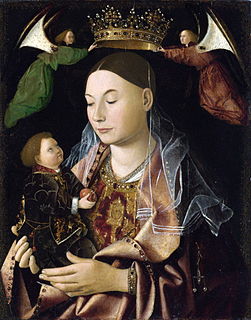
Antonello da Messina, properly Antonello di Giovanni di Antonio, but also called Antonello degli Antoni and Anglicized as Anthony of Messina, was a Sicilian painter from Messina, active during the Early Italian Renaissance. His work shows strong influences from Early Netherlandish painting, although there is no documentary evidence that he ever travelled beyond Italy. Giorgio Vasari credited him with the introduction of oil painting into Italy. Unusually for a south Italian artist of the Renaissance, his work proved influential on painters in northern Italy, especially in Venice.

Polidoro Caldara, usually known as Polidoro da Caravaggio was an Italian painter of the Mannerist period, "arguably the most gifted and certainly the least conventional of Raphael's pupils", who was best known for his now-vanished paintings on the facades of Roman houses. He was unrelated to the later painter Michelangelo Merisi da Caravaggio, usually known just as Caravaggio, but both came from the town of Caravaggio.
"Ecce homo", is a phrase uttered by Pontius Pilate at the trial of Christ.

St Sebastian is a painting, once part of a triptych by the Italian Renaissance artist Antonello da Messina, completed in 1477-9. It is housed in the Gemäldegalerie Alte Meister, Dresden, Germany.

Christ at the Column is a small painting by the Italian Renaissance artist Antonello da Messina, executed c. 1476-1478, showing the Flagellation of Christ. It is in the Louvre in Paris.
Crucifixion is an ancient method of execution.
The Annunciation is the announcement to Mary that she would conceive the Son of God.
Calvary is the hill in Jerusalem where Jesus was crucified.
Ecce Homo is the title of a series of paintings by the Italian Renaissance master Antonello da Messina. They date from 1470 to 1475.

The Madonna with Child is a painting attributed on basis of style to the early Italian Renaissance master Antonello da Messina, depicting the Madona holding the doll-like Child and wearing an ornate golden crown, held by angels over her head. It is housed in the National Gallery, London. The name Salting, which is also applied to a Madonna by Robert Campin, denotes George Salting, the collector who donated it to the gallery in 1910.

Mariano Riccio was an Italian painter of the Renaissance period.

The Flagellation of Christ, sometimes known as Christ at the Column or the Scourging at the Pillar, is a scene from the Passion of Christ very frequently shown in Christian art, in cycles of the Passion or the larger subject of the Life of Christ. It is the fourth station of the modern alternate Stations of the Cross, and a Sorrowful Mystery of the Rosary. The column to which Christ is normally tied, and the rope, scourge, whip or birch are elements in the Arma Christi. The Basilica di Santa Prassede in Rome claims to possess the original column.
Saint Jerome in His Study may refer to the following paintings, which depict Saint Jerome:

The Annunciation is a painting by the Italian Renaissance master Antonello da Messina, executed in 1474. It is housed in the Bellomo Palace Regional Gallery, in the historical center of Syracuse, Sicily.

Lamentation (Pietà) is an oil painting on panel of the common subject of the Lamentation of Christ that is now regarded as by an artist in the "circle" of the Early Netherlandish painter Petrus Christus, rather than by Christus himself. It was painted in c. 1444, and is now in the Louvre in Paris.
Virgin Annunciate may refer to two paintings by the Italian Renaissance artist Antonello da Messina:

San Gregorio Polyptych is a polyptych painting by the Italian Renaissance master Antonello da Messina, completed in 1473 and housed in the Regional Museum of Messina, southern Italy.
Portrait of a Man may refer to:

The Museo Interdisciplinare Regionale (MuMe). or Regional Museum of Messina, is an art museum located on the northern coast of the city of Messina, Sicily, Italy.

The Interdisciplinary Regional Museum of Messina is a museum of painting, sculpture and archaeology in the city of Messina. Until 2017 it was housed in the former Barbera-Mellinghoff silk-mill, a late 19th century building chosen for it after the 1908 Messina earthquake. Since 2017 it has been housed in a nearby complex designed in the 1970s.
This page is based on this
Wikipedia article Text is available under the
CC BY-SA 4.0 license; additional terms may apply.
Images, videos and audio are available under their respective licenses.










